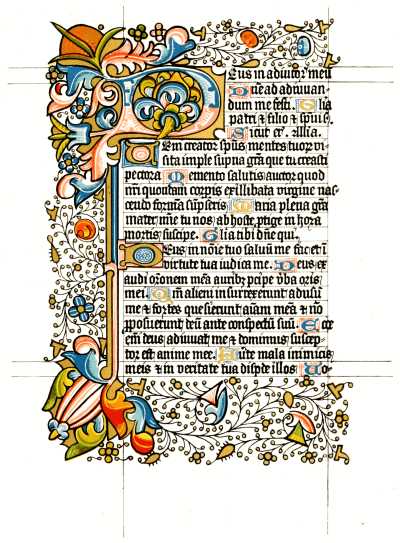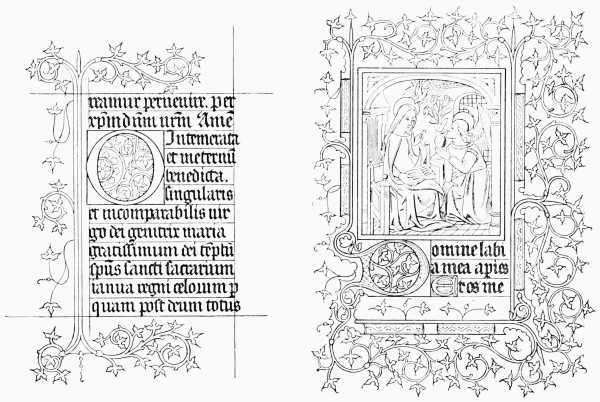

Left: Plate IV. Facsimile of Mansucript in Lambeth Palace Library, 15th Century. Right: Pages from a Book of Hours of Fourteenth Century from Lessons in the Art of Illuminating by W. J. Loftie. Source: Project Gutenberg EBook #40423 produced by Chris Curnow, Matthew Wheaton and the Online Distributed Proofreading Team. [Click on images to enlarge them.]
Description of Plate IV

ur next Plate is from a manuscript in the Lambeth Library. Leave to copy it was readily granted to us by the lamented Archbishop Tait. It is No. 459 in the Library Catalogue, and contains no fewer than twenty miniatures, as well as borders like this one. It belongs like Plate IX. (the Frontispiece) to the English flower pattern style of the fifteenth century, and is remarkable for the sober effect of the gorgeous colors employed, and for the delicacy of the scroll-work in black.
A great deal of this effect is due to the application of gold. The illuminators employed both what we call "shell gold" and leaf. They attached the greatest importance to skill in gilding, and the result is that their "raising" survives after centuries, when that executed at the present day often cracks off after a few weeks or months, if not very carefully handled. Many books, containing the secret of making these preparations, and sizes of all kinds, are in existence; and show that while the same end was attained by many different kinds of processes, one ingredient was never omitted, namely, great care and pains, and the gradual gathering of skill through experience.
It is difficult to explain the method of using gold-leaf without an actual demonstration: and the student will learn more in ten minutes by watching a competent gilder than by reading a library of books on the subject. The "raising" is to be obtained from any artist's colorman, and nothing but practice long and assiduous can secure the power to use it. The same rule must be laid down for burnishing, which is an art not to be acquired in a day. It might be well to commence with the dotted work, common in the fourteenth century, and when we have learned to make a burnished dot with our agate point we may go on and burnish a larger surface. The effect of burnished leaf gold cannot be given in chromo-lithography, but it may be worth while to remark that all the gilding in the original illumination from which this Plate is copied is burnished on a raised surface, even the small letters in the text.
The colors employed by the copier were of a more mixed and complicated character than those for the other page from the Lambeth Library. The reason is apparent in a moment on comparing the two. In this page the brilliancy is so tempered as to produce a comparatively subdued effect. In the General Sketch mention has already been made of miniatures in which the artist restricted himself to the use of certain colors, so as to insure a peculiar and delicate effect. Here there has been no such restriction, but each color has been softened and so worked over with patterns and lines in body white or in pale yellow, that there is no glare or contrast. The student should be careful how he obtains harmony by this method, as he may find all his work weakened and paled; but, skilfully used, the system may be made to produce the most charming results.
The blue is Prussian, over which are dots and lines of Chinese White. The pink is obtained by mixing Lake and Chinese White, shaded with darker Lake, and also heightened with white lines and dots. The orange is pale Indian Yellow shaded with Burnt Sienna, and with an admixture of Lake in the deeper shadows. The green in this example is obtained by mixing Prussian Blue and Indian Yellow in different proportions.
On the back of Plate IV. are two more outlines from Mr. Robert Young's little French Book of Hours. They are admirable models of a kind of work which for fully half a century was to France what the "flower pattern" was to England. The branches are generally dark blue delicately lined with white. The leaves are sometimes gold, that is where there is not already a gold ground, and sometimes yellow, red, and blue. The prevailing tint is blue, and in some pages no other color, besides the gilding, is employed.
Some outline borders and ornaments of the same period and style are to be found on the back of Plates V. and VI. The coloring of some of them will be indicated by a reference to Plates III. and I.
References
Beckwith, Alice H. R. H. Victorian Bibliomania: The Illuminated Book in Nineteenth-Century Britain. Exhibition catalogue. Providence. Rhode Island: Museum of Art, Rhode Island School of Design, 1987.
Loftie, W. J. . Lessons in the Art of Illuminating: A Series of Examples selected from Works in the British Museum, Lambeth Palace Library, and the South Kensington Museum.. London: London: Blackie & Son, nd. “The Colored Illustrations are Printed by W. G. Blackie & Co., Glasgow, from Drawings by J. A. Burt.” Project Gutenberg EBook #40423 produced by Chris Curnow, Matthew Wheaton and the Online Distributed Proofreading Team. Web. 11 January 2014.
Last modified 11 January 2014